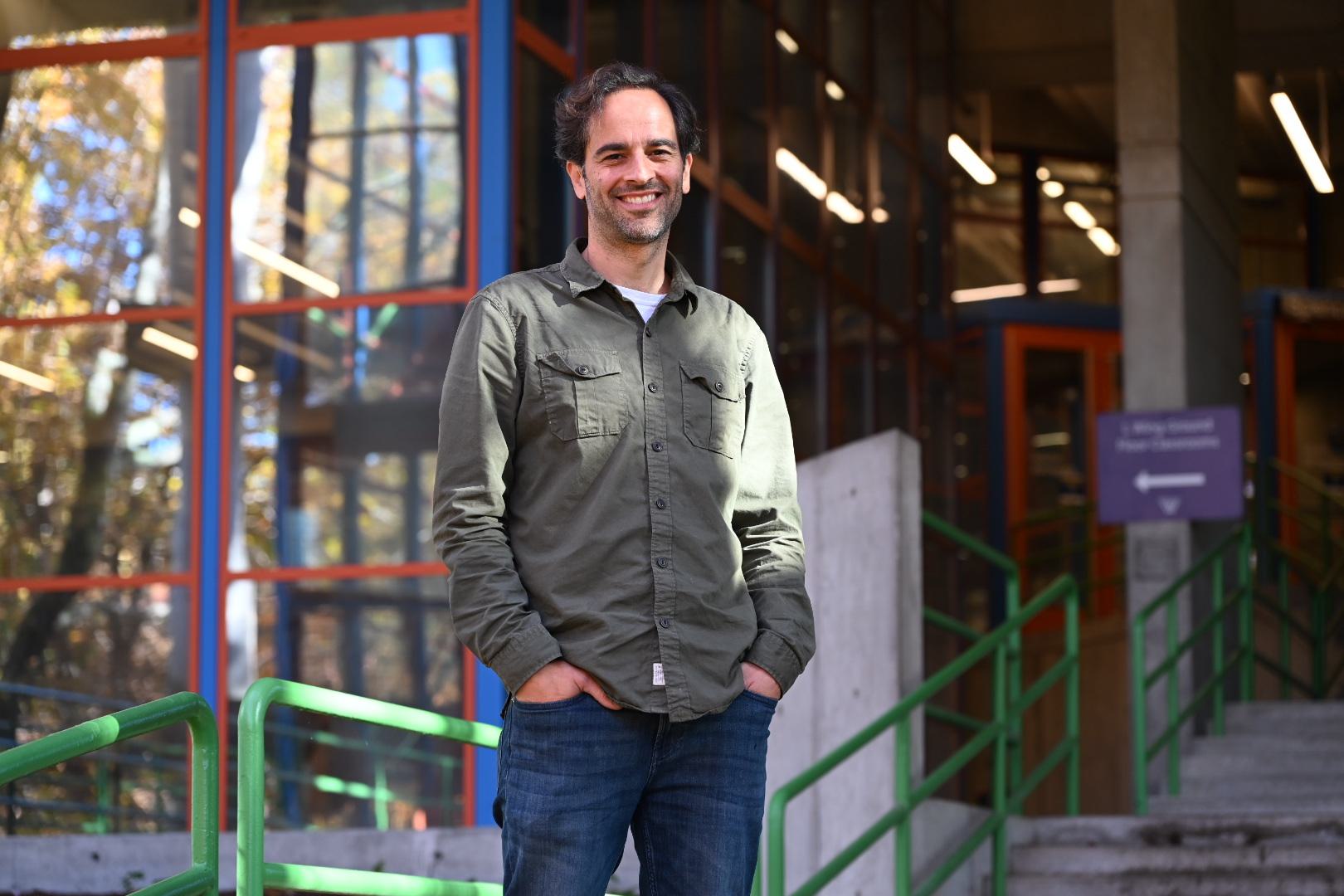On October 27, James Battat, associate professor of physics at Wellesley, was named a member of the inaugural cohort of the Gordon and Betty Moore Foundation’s Experimental Physics Investigators, a group of 16 midcareer scientists who show promise in advancing the scientific frontier in experimental physics. Over the next five years Battat, the only member of the cohort to hail from a liberal arts college, will receive a total of $1.25 million to support his efforts to build a new neutrino detection technology.
Battat has spent his career investigating some of the most intriguing mysteries at the heart of the universe and developing technologies to better understand the fundamental interactions in physics and astrophysics. Over the years, he has searched for a new theory of gravity, built instrumentation designed to locate dark matter, and looked for experimental clues to unite quantum mechanics and gravity.
“For much of my career, that meant looking for signals that may or may not be there, and finding opportunities to develop detector technologies that can open new windows of discovery in particle astrophysics,” Battat said. “A lot of my earlier work involved measuring ‘nothing’ better and better.”
In 2020, Battat turned his attention to particles that we know exist—and some of the most mysterious particles known to science. Neutrinos, the particles at the heart of Battat’s research, are nearly massless and travel almost as fast as light. Though they are among the most abundant particles in the universe, they pass through most matter unnoticed.
“Approximately 100 billion pass through your fingertip every second, and yet leave no trace,” Battat said. “Many of their qualities read more like science fiction than reality.” For example, three types of neutrinos, called “flavors,” can spontaneously transform into one another. “Imagine the apple in your kitchen suddenly morphing into an orange,” Battat said. “Neutrinos are capable of such a feat.”
Battat’s neutrino detection project aligns with his previous research ambitions, but he said it is “the first experiment for me where I know the particle exists.” “It’s reassuring to know we are going to see something,” he said. “We just don’t know what that might be.”
Battat shifted his research focus in 2020 with the help of a Brachman Hoffman Fellowship, which supports tenured and tenure-track faculty at Wellesley who want to conduct research in a new area or direction. He was able to buy new test and measurement equipment for his lab and hire research assistants, and the resulting work had a direct impact on his Moore Foundation proposal: “That played a key part in its ultimate success.”
Much of Battat’s research for the near term is motivated by the Deep Underground Neutrino Experiment (DUNE), a massive international scientific effort that seeks to track neutrinos on Earth. DUNE, which Battat joined in September 2020, is an initiative composed of over 1,400 researchers from more than 200 institutions in 35 countries. When completed, the project Battat and his colleagues are working on will consist of two neutrino detectors placed in the world’s most intense neutrino beam. One detector will record particle interactions near the source of the beam, at the Fermi National Accelerator Laboratory in Batavia, Ill., and a second, much larger detector will be installed more than a kilometer underground at the Sanford Underground Research Facility in Lead, S.D., more than 1,300 kilometers from the source. Scientists will use these detectors to obtain precision measurements of neutrino properties and possibly transform the understanding of neutrinos and their role in the universe.
The project is a massive undertaking. “It would be like building Wellesley’s Science Complex almost a mile beneath the ground,” Battat said of the South Dakota facility, adding that the scale of the challenge was so interesting that it made him shift his research focus from dark matter to neutrinos. “I thought I could make a contribution to that effort, and bring creative ways to solve the challenges of building these detectors.
Battat works on multiple readout systems for DUNE, including an instrument called the Digital Wire Analyzer, and a novel pixelated readout system called Q-Pix, which aims to enhance DUNE’s sensitivity to the physics of neutrinos. Battat believes the Q-Pix design he and other scientists around the country are working on will optimize the discovery potential of large-scale particle physics experiments that could be undertaken at DUNE and in other research facilities. At Wellesley, Battat’s lab is developing a prototype Q-Pix system, and once it is available to test, Battat and his research assistants will play a central role in assessing its performance.
Through this research, Battat ultimately hopes to explain some of the most fundamental mysteries of physics, including the matter-antimatter asymmetry problem.
“In order for there to be matter today, there must have been slightly more matter than antimatter,” Battat said. “The standard model of particle physics cannot explain this imbalance. But there are hints that neutrinos might break the symmetry between matter and antimatter, violate equilibrium, and serve as the underlying mechanism that leaves matter in the universe, and allows us, and everything, to exist.”
Battat said the Gordon and Betty Moore Foundation grant will “transform the scope and scale of what I can do, and the five-year timeline will provide long-term stability that will be really impactful.” He is also excited about collaborating with his cohort of fellows, a prospect the foundation encourages.
“The award targets midcareer experimental physicists, and people whose projects are high risk and high reward, that federal funding agencies might consider too risky but that might be promising in the long term,” Battat said. “I look forward to interactions with other awardees, from all over the country, to learn about their work. Those conversations might push my research in new directions. I’m looking forward to that cross-fertilization and community building. And I will continue to be open to change.”
